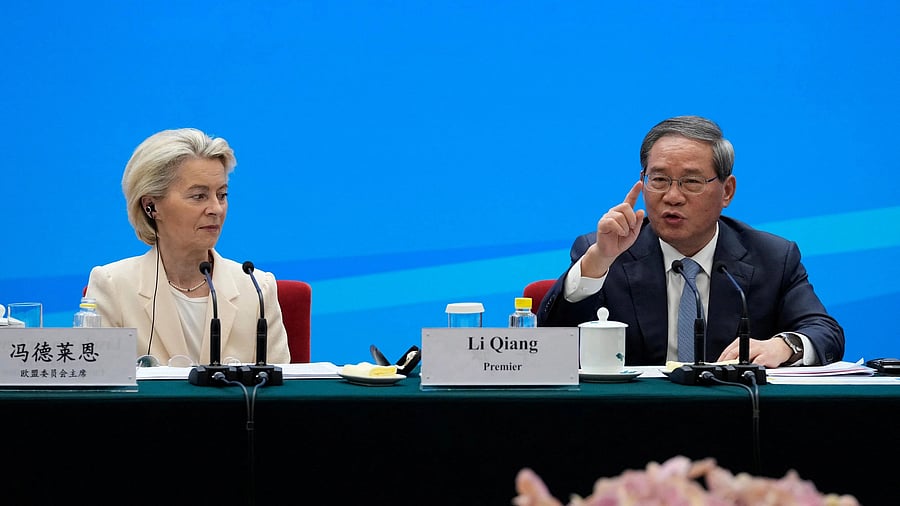
Chinese Premier Li Qiang speaks as European Commission President Ursula von der Leyen looks on during the EU-China Business leaders symposium at the Great Hall of the People in Beijing, China, July 24, 2025.
Credit: Reuters Photo
The 25th EU-China Summit in Beijing, intended to commemorate 50 years of diplomatic relations, unfolded under an atmosphere of tension and discord. Far from a celebratory occasion, the summit, abruptly shortened to a single day at China’s request, was dominated by unresolved disputes over trade, industrial policy, and geopolitics. The meeting took place against the backdrop of mounting pressure on the EU from the United States for a rebalanced transatlantic trade deal. Together, these developments underscored a deeper truth: the EU remains structurally ill-equipped to credibly escalate tensions with either Washington or Beijing, limiting its diplomatic leverage on both fronts.
There was speculation that tensions within the transatlantic alliance might prompt China to adopt a more conciliatory stance towards Europe. However, Beijing has taken a more assertive posture, repurposing tools initially designed for leverage in the US-China trade dispute to exert pressure on the EU instead. Among these is China’s export control regime, now used to constrain European assertiveness, threaten escalation, and extract concessions.
One of the clearest illustrations of this is China’s tightening grip on rare earth exports, vital for European industries and defence modernisation. Although the summit produced a vague commitment to create an “upgraded supply chain mechanism” to manage disruptions, confidence remains low that these controls will be eased in any meaningful way. European companies reliant on these materials are warning that dwindling stockpiles could halt production within weeks. For China, the so-called “upgraded supply chain mechanism” is likely to serve not as a solution, but as another platform to push back against EU policies.
While the European defence sector represents a relatively small portion of demand for Chinese rare earths in value terms, access to these materials is strategically indispensable. European defence firms are taking steps to diversify supply chains, but the urgency is growing. It would be unrealistic to expect China to willingly support Europe’s rearmament while the EU actively seeks to deny advanced technologies to the Chinese military.
The European Commission now officially describes the EU-China trade relationship as “critically unbalanced”. Brussels continues to activate trade defence instruments targeting Chinese market distortions, particularly in the electric vehicle and medical device sectors. Despite these efforts, the Chinese trade surplus with the EU exceeded €300 billion in 2024 and continued to grow in 2025.
Beijing has largely deflected European negotiators’ complaints about market access in sectors like cosmetics, meat, and pharmaceuticals by flooding the relationship with a barrage of smaller, intractable disputes, effectively distracting from a broader strategic rebalancing effort.
The EU has managed to prevent its member states from pursuing bilateral “green corridor” deals with China that would have undermined collective bargaining power: one of the few positive takeaways from an otherwise fractious summit.
The Russian connection
China’s second key objective vis-à-vis the EU is to preserve its strategic alignment with Russia while minimising European consequences. Remarkably, Beijing has succeeded thus far. One week ahead of the summit, the European Council adopted its 18th sanctions package targeting Russia’s war machinery. It included seven Chinese entities implicated in circumventing export restrictions, including the supply of UAV components.
Unlike previously, Beijing reacted strongly to the inclusion of two banks from Northeast China – Suifenhe Rural Commercial Bank and Heihe Rural Commercial Bank – accused of facilitating cross-border military trade with Russia. MOFCOM pledged necessary retaliatory steps, indicating a heightened sensitivity to financial sector sanctions. Beijing may now leverage its export control regime in response. China’s Foreign Trade Law allows it to impose “countermeasures” against any “prohibitive, restrictive, or other similar measures”.
Evidence continues to appear of Chinese support for Russia’s war effort. The latest revelations show Chinese-made engines, falsely labelled as refrigeration units, reaching Russian drone manufacturer IEMZ Kupol. These engines power the Garpiya-A1 drone, widely used in Ukraine. Europe’s patience is wearing thin. Beijing’s dual-track strategy has not yet triggered a full-blown rupture in EU-China relations, but the tension is mounting.
European Commission President Ursula von der Leyen described the EU-China relationship as reaching an “inflection point.” The EU’s summit press release clarified what this means: while they remain open to constructive dialogue, it will no longer hesitate to take “proportionate, legally compliant action” to protect its interests.
More trade defence measures against China’s market distortions are almost certain. The result will be a continuing cycle of confrontation and retaliation. As long as Beijing treats access to the European market as a given and continues to support Russia’s war effort without consequences, the EU-China relationship is likely to remain stuck in a slow but steady state of deterioration.
(The writer is a former ambassador of India to Germany, Indonesia, and Ethiopia)
Disclaimer: The views expressed above are the author's own. They do not necessarily reflect the views of DH.